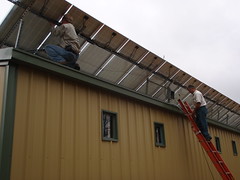
Green money is pouring into Austin, Texas, which now has to decide how to
spend it.
Sandra Zaragoza,
writing in Portfolio.com, looks into what to do with it:
Last week, American Youthworks, a nonprofit aimed at at-risk youth,
received $1.4 million in federal funds to build a green charter high
school that will prepare students for jobs in solar-panel installation,
green facilities management, and other jobs.
In the last few years, Austin Community College received $99,031 from
Workforce Solutions for solar and weatherization training and, more
recently, $59,800 from the Department of Labor to increase the number
of women in green job training programs.
And ACC is hoping to bring more funding to Central Texas in federal grants. ACC is part of a group of Texas community colleges that have
applied for $3.5 million in funding to build solar-energy training
programs.
Education, solar, weatherization; who could argue with those things?
But do those functions create new jobs?
Continue reading →
 A press release by Southface promises:
A press release by Southface promises:





